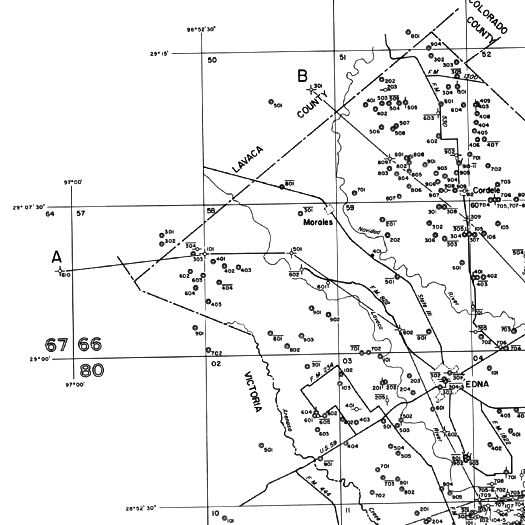
[Detail from a map of groundwater wells in Jackson County, Texas, drawn by the U.S.G.S. in cooperation with the Texas Water Development Board and Jackson County; satellite studies of groundwater levels — which use small changes in the Earth’s gravitational field to detect fluctuations in groundwater reserves — have indicated extreme depletion in Texas as a result of that state’s current drought.]
The Guardian reports on new research that quantifies the contribution of aquifer depletion (primarily through the artificial conveyance of water to the surface via deep wells) to sea level rise — “five times bigger in scale than the melting of the planet’s two great ice caps, in Greenland and Antarctica”:
“Trillions of tonnes of water have been pumped up from deep underground reservoirs in every part of the world and then channelled into fields and pipes to keep communities fed and watered. The water then flows into the oceans, but far more quickly than the ancient aquifers are replenished by rains. The global tide would be rising even more quickly but for the fact that man-made reservoirs have, until now, held back the flow by storing huge amounts of water on land.
…
The new research was led by Yadu Pokhrel, at the University of Tokyo, and published in Nature Geoscience. “Our study is based on a state-of-the-art model which we have extensively validated in our previous works,” he said. “It suggests groundwater is a major contributor to the observed sea level rise.” The team’s results also neatly fill a gap scientists had identified between the rise in sea level observed by tide gauges and the contribution calculated to come from melting ice.
The drawing of water from deep wells has caused the sea to rise by an average of a millimetre every year since 1961, the researchers concluded. The storing of freshwater in reservoirs has offset about 40% of that, but the scientists warn that this effect is diminishing.”
It is worth noting, as one of the scientists consulted by the Guardian does, that where many of the defining trends of the Anthropocene are accelerating (so commonly that one might be tempted to say that acceleration is the defining characteristic of the Anthropocene itself), the contribution of groundwater withdrawal to sea level rise appears to have held steady over the past fifty years or so, suggesting that the relative contribution of groundwater withdrawal will decline as other contributors accelerate. Despite that, the picture the study and article paint remains utterly fascinating to me: a world where the aggregate suction of a global economy’s worth of groundwater wells is contributing meaningfully to a massive phenomenon like sea level rise.
[Link via Anson Mackay and Erle Ellis on twitter; risings seas and gravitational flux on mammoth, previously: “the ambiguity of seamelt and landrise”.]

